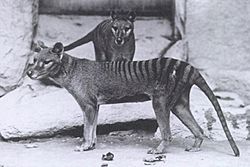Thylacinus facts for kids
Quick facts for kids Thylacinus |
|
|---|---|
 |
|
| Thylacine | |
| Conservation status | |
| Scientific classification | |
| Kingdom: | |
| Phylum: | |
| Class: | |
| Infraclass: | |
| Order: | |
| Family: | |
| Genus: |
†Thylacinus
Temminck, 1824
|
The genus Thylacinus is a group of extinct meat-eating marsupials. A genus is a way to group very similar animals together. The most famous animal from this group is the Thylacine, also known as the Tasmanian Tiger. Sadly, all animals in the Thylacinus genus are no longer alive today. They belonged to a special group of marsupials called Dasyuromorphia.
Contents
What Are Thylacines?
The word Thylacinus comes from Greek words meaning "pouch dog." This is because these animals were marsupials, like kangaroos or koalas, meaning the mothers carried their young in a pouch. They were also carnivores, which means they ate meat.
The most well-known species was the Thylacinus cynocephalus, often called the Tasmanian Tiger or Tasmanian Wolf. It was a unique animal that looked a bit like a dog with stripes on its back, like a tiger.
Meet the Thylacine (Tasmanian Tiger)
When Did the Thylacine Live?
The Tasmanian Tiger lived from the Early Pliocene epoch until 1936. This means they were around for millions of years! The last known Thylacine died in a zoo in Tasmania in 1936.
Where Did the Thylacine Live?
Thylacines used to live across mainland Australia and New Guinea. However, by the time Europeans arrived, they were only found on the island of Tasmania. They preferred forests, grasslands, and wetlands.
What Did the Thylacine Look Like?
The Thylacine was a medium-sized animal, about the size of a large dog. It had a stiff tail that tapered to a point. Its fur was yellowish-brown, and it had 13 to 21 dark stripes across its back, from its shoulders to its tail. These stripes gave it the "tiger" part of its name. It also had a very wide gape, meaning it could open its mouth incredibly wide.
What Did the Thylacine Eat?
As a carnivore, the Thylacine hunted other animals. Scientists believe they ate kangaroos, wallabies, birds, and other small animals. They were skilled hunters, using their strong jaws and teeth to catch prey.
Other Ancient Thylacine Species
Besides the famous Tasmanian Tiger, there were other species in the Thylacinus genus. These species lived much, much longer ago. We know about them from their fossils.
- Thylacinus macnessi: This species lived during the Upper Oligocene and Lower Miocene epochs. It's one of the oldest known members of the group.
- Thylacinus megiriani: This species lived during the Upper Miocene epoch.
- Thylacinus potens: This species also lived during the Lower Miocene epoch.
- Thylacinus rostralis: Another ancient species from this group.
These older species help scientists understand how the Thylacinus family changed over millions of years.
Why Did Thylacines Disappear?
The Tasmanian Tiger became extinct due to several reasons. Hunting by humans was a major factor. Farmers believed Thylacines were killing their sheep, so they hunted them. Habitat loss, as people cleared land for farming, also played a role. Diseases and competition with other animals, like wild dogs, might have also contributed to their decline. It's a sad reminder of how human actions can affect wildlife.
See also
 In Spanish: Thylacinus para niños
In Spanish: Thylacinus para niños

